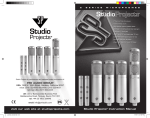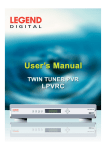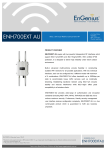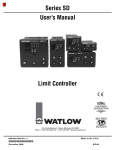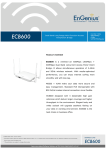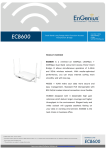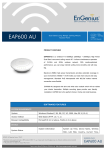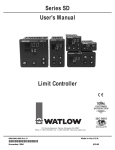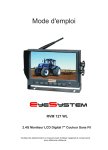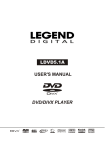Download LEGEND INSTALLATION GUIDE:
Transcript
USER MANUAL LSD2 – LEGEND STANDARD DEFINITION SET TOP BOX www.legenddigital.com www.legenddigital.com v1.2 CONTENTS Safety Instruction Packing List Front Panel Rear Panel Remote Controller Installation Guide EPG Feature Specification 3 4 5 5 6 7-11 12 12 13 2 SAFETY INSTRUCTIONS Please read the following instruction carefully: Do not overload power outlets, extension cords or integral convenience receptacles as this can result in a risk of fire or electrical shock Never allow liquids, spray or other materials to come into contact with the inside of the Set Top Box (STB). Unplug the STB from the power outlet before cleaning. Use a soft cloth and a mild solution of washing-up liquid to clean the exterior of the STB. Allow a clear space around the STB for sufficient ventilation. Do not use the STB where it is exposed to direct sunlight or heat. Never stack other electronic equipment on top of the STB. Locate the STB in an indoor place to prevent exposing from lightening, rain and direct sunlight. Do not use any attachments as these may cause hazards or damage the equipment. Do not connect or modify the power cable attached to the STB. Do not cover or place the STB on a unit that emits heat. This symbol indicates “dangerous voltage” inside the product that present a risk of electric shock or personal injury. This symbol indicates important instructions accompanying the product. TO REDUCE THE RISK OF ELECTRIC SHOCK DO NOT REMOVE COVER (OR BACK) NO USER SERVICEABLE PARTS INSIDE REFER SERVICING TO QUALIFIED SERVICE PERSONNEL 3 PACKING LIST ITEMS Qty. DIGITAL TERRESTRIAL RECEIVER 1 INSTRUCTION MANUAL 1 REMOTE CONTROL 1 AV CABLE 1 REMARK Batteries inc NOTE: Any changes will not be noticed in advance. Our company reserves the rights for the explanation of the discrepancy. 4 FRONT PANEL 1 6 3 5 2 4 1. Card slot (NOT USED FOR AUSTRALIA) 2. EXIT: return to the program-watching status 3. MENU: Menu entry 4. OK: menu confirmation/ channel list 5. Remote receiver LED display window 7 8 10 9 6. Standby switch 7. Volume decrease/ left button 8. Channel increase/ up button 9. Volume increase/ right button 10. Channel decrease/ down button REAR PANEL 1 2 3 4 5 6 1. Power switch 5. Video signal output terminal 2. Loop output terminal 6. Audio signal output terminal 3. Antenna signal input terminal 4. Serial data interface – only use for software upgrades 5 REMOTE CONTROLLER KEYS Advise you operate each function of the STB using the button on the remote controller. Please read this section to help advance your understanding of the function of the STB. 1. : Standby control 2. : mute the audio output 3. FAV : Non-Menu Mode: Select FAV list 4. TEXT : Non-Menu Mode: TEXT Teletext 5-6. ▲/▼ : Menu Mode : Move cursor up/down Non-Menu Mode: Program serial increase / decrease 7-8. -/+: Menu Mode: Left or right button Non-Menu mode: Volume decrease / increase 9. EXIT: Exit / Go back 10. MENU: Invoke or exit the menu operation 11. Numeric buttons 0-9: Input digits 12. SUB: Subtitles 13. TV/ RAD: Switch between TV and Radio 14. PAUSE: Non-Menu mode: Pause Picture 15. INFO: program’s Information 16. RECALL: Recall last channel 17. EPG: Electronic Program Guide 18. MULTI-FUNCTION Buttons: red (audio language) green, yellow, blue (Electronic Program Guide) 19. OK: Non- Menu Mode: Channel List Menu Mode Mode: Confirmation PRECAUTIONS ABOUT BATTERIES Improper use of batteries may cause corrosion or fluid leakage. Please observe the following instructions for the safe use of batteries 1. Do not mix up the polarities of batteries 2. Never leave dead batteries in the remote control 3. Remove batteries from the remote controller if it is not going to be used for a certain time 4. Do not attempt to disassemble, short-circuit, heat, recharge or throw the batteries into a fire. 5. Do not use new & old batteries together, or different types of batteries. 6. Wipe away any electrolyte fluid inside the remote controller, and insert new batteries 6 LEGEND INSTALLATION GUIDE: LSD2 – LEGEND STANDARD DEFINITION SET TOP BOX This document will guide you step by step on how to connect and set up your LSD2 set top box. Users with experience in entertainment systems setup may not require this document as it is intended for those with little or no prior knowledge on these units. 1) Place the unit in a suitable location near your TV. The unit should not be placed directly on or under another electrical device (as this may cause interference) and should have some room at the sides and top to allow the unit to remain cool. 2) Plug the unit’s power cord into your wall socket and turn on at the wall. On the back of the unit, press IN the round POWER button. Power is OFF Power is ON 3) You should now see green lights on the front display of the unit (if you only have 1 green LED but no information is displayed on the front LCD, your unit is in standby. Press the power button on the FRONT and you will see the LCD activate and show green indicator bars). If all is well you should see this: 7 4) You now must connect your aerial. You may have an inside aerial (rabbit ear type) or a roof antenna with a wall plug. Using an appropriate cable, connect the aerial to the RF IN connection on the rear of the unit (top middle) as below: 5) Now you must connect the AV cables (the red, white, and yellow cables that came with your unit) to the rear of the unit. The cables are colour coded; simply connect them with the colours matching. 8 Diagram above shows all connections in place for LSD2. Read on for further instruction. 6) The other end of the AV cables will need to then be connected, in the same way, to the AV-INPUT connectors on either your VCR or your TV. In order to record from your digital box to videocassette, you will need to connect the unit direct to the VCR (set VCR to appropriate AV channel as indicated on the connection you use, eg AV1, AV2…) and then connect the VCR to the TV as per normal. Otherwise, connect the unit direct to the TV (in this case, set the TV to appropriate AV channel as indicated on the connection you use, eg AV1, AV2…). 7) If you have made the connections correctly, everything is turned on, and you are set to the correct AV channels, you will now see this image on your TV screen: 9 8) Now you must SCAN in your channels. Make sure the batteries (supplied) are installed in your REMOTE CONTROL unit. Point the remote at the digital box and press MENU. Then use the up and down buttons on the remote to highlight SCAN at the bottom of the menu, and press OK. You should see the following: 9) After checking that the SCAN TYPE is set on AUTO, and the BAND WIDTH is set to 7MHz (leave the Channel Number field BLANK), use the down button to highlight START SCAN and then press OK. You will see the unit picking up channels as it scans, like this: 10 10) When the scan is completed, the detected channels will automatically be saved, and the unit will exit from the menu. *** IMPORTANT *** If your unit does not find any channels, then the aerial is not connected properly or your reception is very poor. Your antenna may need to be tested/adjusted, or you may require an inline “signal booster” to amplify the weak signal in your area. Your local TV service technician can assist with these. 11) If everything has been done right, you have been TURNED ON with Legend Digital! You may now enjoy the benefits of Digital Television, and can refer to your user manual for further operating instructions. 11 EPG – Electronic Program Guide To show information on programs currently playing press the EPG button. Press the red key to show information on the current program and the green key to show what program is on next. Press the yellow key to read the particulars. Press the blue key to show the weekly information. FEATURES Auto, manual and NIT convenient channel scan Tremendous storage of channels Six users defined Favorite modes (news, sports, cinema, MTV, economy and art) EPG / Recall / Still Subtitle instruction self-select AV aspect selectivity self-control Menu and channel locking function Timer function Factory reset (initialization) function High Sensitive Tuner LED display component Automatic PAL / NTSC Detection More particular text offering Signal loop output terminal Convenient software up-grade (pc to box; box to box) Powerful edit abilities (rename, add, delete, sort) channels 12 1 SPECIFICATION Tuner Input Frequency UHF 470 MHz ~ 862 MHz VHF 174 MHz ~230 MHz RF Input Level -78dBm ~ -20dBm (75W) RF Input connector IEC type Female RF Output connector IEC type Male Nominal input impedance 75 ohm Channel selection system Electronic tuning, PLL synthesizer Step frequency 166.67KHz Channel Decode Demodulation COFDM Video Profile Level MPEG-II MP@ ML Output System NTSC / PAL Output Terminal RCA, TV Scart, VCR scart Output Level 1Vp-p (75W) (RCA) Audio Audio Decoding MPEG-II layer I & II Freq response 20Hz ~ 20kHz Output Level Adjustable (600W unbalance) Working condition Power supply voltage AC: 90~240V 50/60 Hz Power consumption About 15W Temperature 0°C ~ 40°C Humidity 10% ~ 90% Size 300 X 210 X 64mm(L/W/H) Weight Approx. 2.4Kg 13














